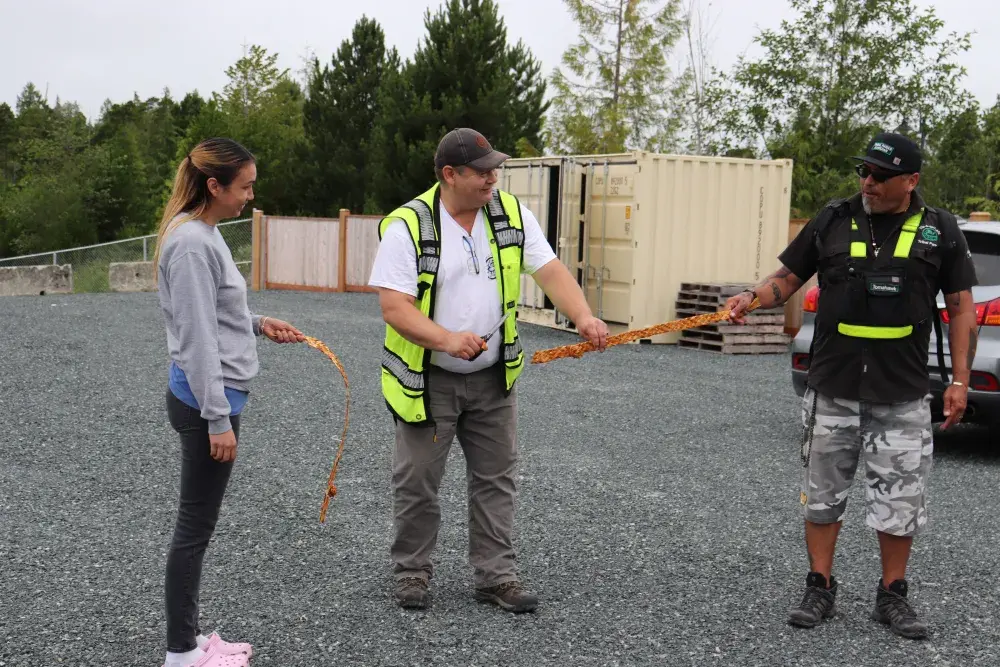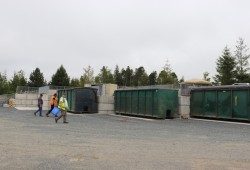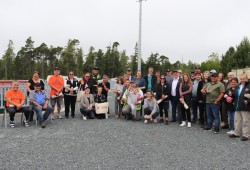Tla-o-qui-aht First Nation (TFN) opened two recycling transfer stations at the beginning of August.
One is located at the Ty-histanis maintenance yard and the second is in Opitsaht where the heritage dump used to be.
The depots feature three large green bins for storing oversized items like mattresses and construction debris as well as electronics, small appliances, automotive items and household hazardous waste. Opitsaht’s site also has a Jora Composter for community organic waste.
“We want to minimize our carbon footprint, we want to make sure to get as much into the recycling stream as possible, work with the other Nations and get to zero waste. That will ultimately lengthen the lifespan of our landfill,” said TFN public works manager Shawn Quick at an Aug. 7 opening event at Ty-histanis.
Saya Masso, TFN’s natural resource manager, welcomed the guests to the opening event on behalf of the ḥaw̓iiḥ (hereditary chiefs) and acknowledged the haḥuułi (territory) for the land and sustenance it gives.
“We ask the Creator for the teachings of respect and strength; that our work today be felt by our grandchildren,” Masso said.
TFN chief councillor Elmer Frank thanked everyone involved with the project.
“We are saving more of our traditional territory from plastics and waste, things that can environmentally impact our haḥuułi,” said Frank, noting that one bag of garbage every two weeks is achievable if citizens use the recycling streams properly.
TFN’s new transfer stations were funded by Indigenous Services Canada as part of the B.C. First Nations Zero Waste Program, an initiative launched in 2008.
“Currently, we have about 115 Nations in the program. No one is excluded, it’s just time. We actually started work here with Ahousaht because they had a big dump on the Island, which has been closed. That was the first one and then slowly Hesquiaht,” said Emily Chu, a community planner that has worked with TFN since 2006.
As the president of the Indigenous Zero Waste Technical Advisory Group (IZWTAG), Lil’wat Nation member Calvin Jameson travels all over B.C. to help improve waste management in First Nations communities.
“The reason why we do it, when I was a superintendent, we were digging holes as deep as we could and burying anything and everything one kilometre above the reservation and four kilometres at the bottom of the hill, I’m tapped into the aquifer and I’m pumping water into the community,” Jameson told the Ha-Shilth-Sa Newspaper at the Aug. 7 event.
“We’re going to contaminate our water if we don’t stop this. The kids are going to have nothing, this is what pushed me over, I resigned from my job and carried on with this,” Jameson continues.
Courtenay-Alberni NDP MP Gord Johns attended TFN’s grand opening.
“They are taking huge leadership when it comes to solid waste management. They are joining a parade of First Nations that are getting support and working together collaboratively to deal with their waste responsibly. Again, it fits in with Indigenous values. This is a great day,” said Johns.
MLA Josie Osborne was also at the event.
“Having infrastructure like this is something that most of us take for granted; we live in modern cities and towns. Sometimes we forget that there are communities like Ty-Histanis, Esowista and Opitsaht, that don’t have this infrastructure,” said Osborne.
“It’s a return to the way things used to be done and fully circular. I think it’s a really great expression of hišukʔiš c̓awaak, everything is one, everything is connected,” she said.
Opitsaht is a small community of about 150 people located across the inlet from Tofino. It costs TFN $2,500 every time a barge goes over to collect debris, and Quick says the new transfer station will likely stretch that monthly trip to every other month or even longer.
The transfer station at Ty-Histanis/Esowista, a community of about 375 members that neighbours Long Beach in the Pacific Rim National Park Reserve, is currently open for locals only during regular maintenance yard hours.



